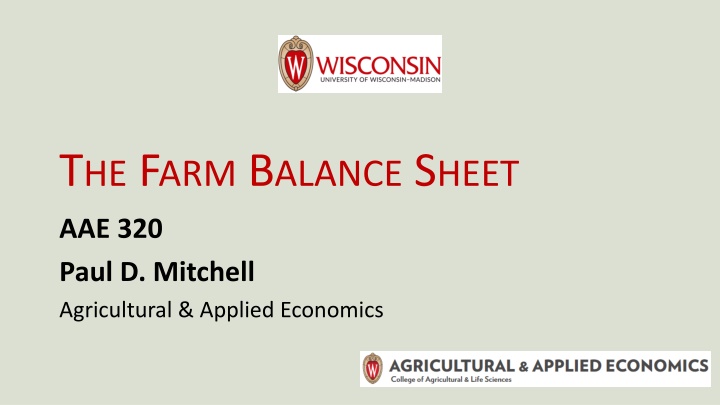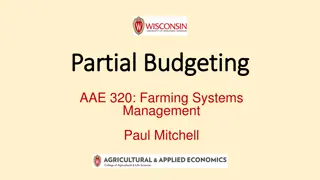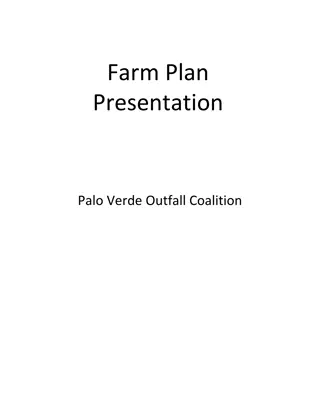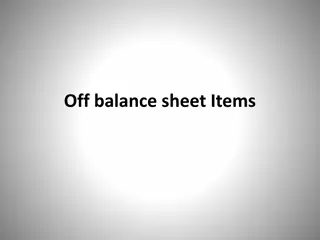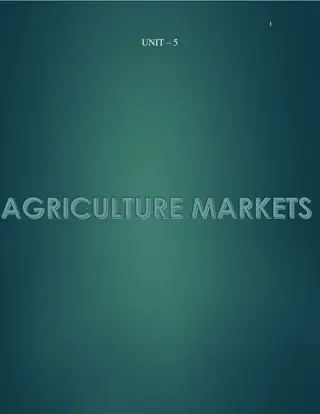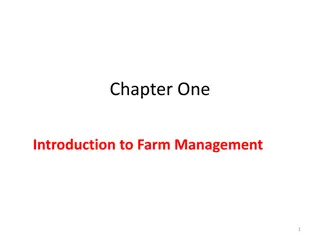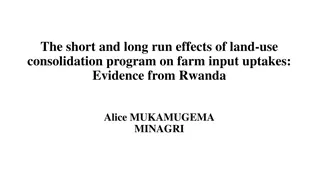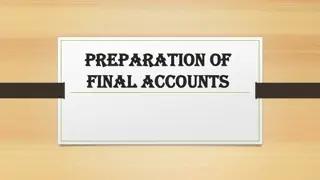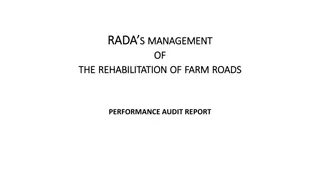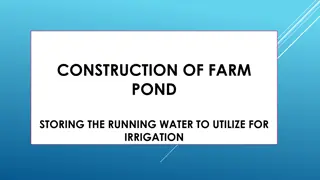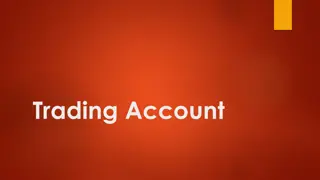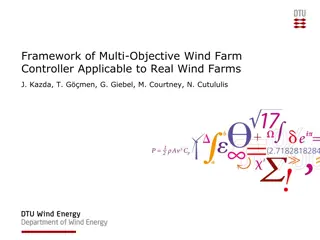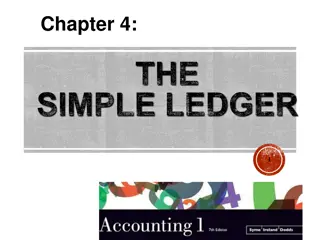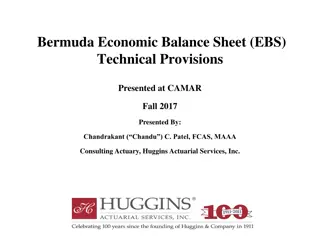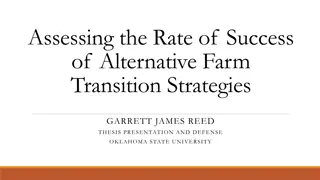Farm Balance Sheet Essentials
Delve into the fundamentals of farm balance sheets, exploring asset valuation, depreciation methods, and the significance of balancing assets, liabilities, and equity. Learn how to create, interpret, and utilize balance sheets to assess a farm's financial health, liquidity, and solvency.
Download Presentation

Please find below an Image/Link to download the presentation.
The content on the website is provided AS IS for your information and personal use only. It may not be sold, licensed, or shared on other websites without obtaining consent from the author.If you encounter any issues during the download, it is possible that the publisher has removed the file from their server.
You are allowed to download the files provided on this website for personal or commercial use, subject to the condition that they are used lawfully. All files are the property of their respective owners.
The content on the website is provided AS IS for your information and personal use only. It may not be sold, licensed, or shared on other websites without obtaining consent from the author.
E N D
Presentation Transcript
THE FARM BALANCE SHEET AAE 320 Paul D. Mitchell Agricultural & Applied Economics
Learning Goals How to create and read a balance sheet for farm operations The difference between a Market Basis and a Cost Basis balance sheet for asset valuation and when to use each one Methods used to depreciate assets Straight line and declining balance How to depreciate farm assets for tax purposes How to use depreciation tables Section 179 depreciation Depreciation recapture (Form 4797)
What is a Balance Sheet? Systematic listing of everything owned and owed by a business/individual Gives statement of owner equity at a point in time Typically for end of accounting period, such as end of year for taxes Interim balance sheets often used/needed for loan applications
Balance Sheet Balance sheet: Everything must balance Asset: anything owned Liability: debt or financial obligation owed The Basic Accounting Identity must hold Assets = Liabilities + Owner Equity Adjust Owner Equity to make it balance Equity is what s left, the residual
Uses of a Balance Sheet Measures financial position of firm, focusing on long and short run measures Solvency: measures relative relationships among assets, liabilities and equity to assess health of firm (financial ratios) Liquidity: measures ability to meet current financial obligations as they come due without disrupting normal business ability to generate cash on short-term
Balance Sheet Format Assets Liabilities Current Assets $100 Current Liabilities $50 Non-Current Assets $150 Non-Current Liabilities $100 Owner Equity $100 Total Assets $250 Total Liability and Equity $250
Assets Anything the firm owns that has value because can sell it and/or use it to produce sellable goods Liquid assets: easy to sell, ready market for them (grain, feeder livestock) Illiquid assets: hard to sell quickly at full value (machinery, land, breeding livestock)
Two Types of Assets on a Balance Sheet Current Assets Cash, bank accounts, marketable funds, accounts receivable (money owed to you), inventories of liquid assets: grain, feed, supplies, feeder livestock Non-Current Assets Everything else: machinery, equipment, breeding livestock, buildings, land
Two Types of Liabilities on a Balance Sheet Obligations/debts owed, any outside claims against your assets Current Liabilities Financial obligations due within 1 year Accounts at suppliers, farm store, etc. Interest & principle on operating and long-term loans Accrued expenses: property and income taxes Non-Current Liabilities Everything else not due in the next year Remaining balance on long-term debts after deducting the current year s payments
Oklahoma State University Example Farm Balance Sheet http://factsheets.okstate.edu/documents/agec-752-developing-a-balance-sheet/
Alternative Balance Sheet Formats Use in Agriculture Traditional farm balance sheets have used other categories, but their use is decreasing Split non-current assets into intermediate and fixed or long- term assets Intermediate Asset: less liquid with life 1 to 10 years (machinery, equipment, perennial crops, breeding livestock) Fixed Asset: > 10 year life: land, buildings Intermediate Liability: 1 10 year loans Long-term Liability: > 10 year loans
University of Minnesota FinPack example https://extension.umn.edu/farm- finance/balance-sheet
Owner Equity = Net Worth Value left after assets are used to cover all liabilities, what you own in the farm Your current investment in the farm Equity changes for many reasons Profits/losses from production activities Sell assets for different values than on sheet Add/withdraw capital from the farm Asset value changes if use market prices for asset valuation, e.g., land value increases
Owner Equity Changes Business transactions only change the mix of assets/liabilities, not owner equity Buying a $10,000 piece of machinery does not change your equity If cash purchase, current assets drop $10,000 and non-current assets increase $10,000 If borrow $10,000, liability increases $10,000 and non-current assets increase $10,000 Equity only changes due to business profit/loss, if you put money in/pull it out, and/or (in some cases) if asset values change
Think Break #9 Assets Liabilities Current Assets $400,000 Current Liabilities $150,000 Non-Current Assets ? Non-Current Liabilities $350,000 Owner Equity ? Total Assets $1,000,000 Total Liability & Equity $1,000,000 Fill in the empty entries in the balance sheet How would the balance sheet change if you bought $100,000 of land by taking $40,000 from your savings and borrowing $60,000 from a bank
Asset Valuation Problem How do you value assets when developing a balance sheet? Typically use two methods: Cost or Market Basis Basic accounting says use Cost basis, but not always right in agriculture Cost Basis: Asset Value = purchase cost minus depreciation, or = farm production cost Market Basis: Asset Value = current market value minus any selling costs
Market Basis Assets valued at current market value minus selling costs Asset value (and so your equity) responds to inflation and price changes, so often gives higher values (and so higher equity) Asset price changes can hide management problems because equity increasing Main Advantage: more accurate measure of current financial status and collateral available for loans, so used by lenders
Cost Basis Asset value = purchase cost minus depreciation, or cost to produce the asset More conservative, following accepted accounting practices in other businesses Equity changes only from retained earnings (profits), not from asset price changes, so used to evaluate ability as a farm manager Can misrepresent true value of business
Farm Financial Standard Committee Recommends using both methods 1) Market basis balance sheet with cost basis asset values in attached schedules or in footnotes 2) Double Column balance sheet for assets, with market basis and cost basis Measure true value market of your business and identify possible management problems
Iowa State University example https://www.extension.iastate.edu/ agdm/wholefarm/html/c3-20.html
Both Methods use Both Methods Farm Asset Value used for Cost Basis Value used for Market Basis Raised grain and feeder livestock Market Market Purchased grain and feeder livestock Minimum of Cost and Market Market Accounts Receivable Cost Cost Prepaid Expenses Cost Cost Investment in crops growing in the field Cost Cost Purchased breeding livestock Cost Market Raised breeding livestock Cost or a Base Value Market Machinery, equipment, buildings, land Cost Market
Grain/Livestock Inventories and Crops in the Fields Grain in the bin and animals on the lot ready to sell use Market Basis: very liquid assets Exception: Purchased grain/livestock that has gone up in value, then use cost if a cost basis balance sheet Crops still growing in the field use a Cost Basis since they are still subject to production risks Don t count your chickens before the eggs hatch
Raised Breeding Livestock Cost Basis You are supposed to accumulate all costs to get each animal from birth to productive age (and not include these in the income statement), and then depreciate this total cost over its useful lifetime just as though purchased it at this price Unrealistic and overly detailed for farms Alternative Develop a fixed base value for each age/type of animal to approximate this cost and its depreciation Base value won t change with asset market prices Think of it as your average cost of production to raise the asset
Depreciation Annual loss in value of a working asset due to use, wear, aging, and technical obsolescence What assets due you depreciate? Useful life > 1 year Useful life can be determined (not unlimited) Machinery, equipment, buildings, fences, breeding livestock, perennial crops, irrigation wells, land improvements (wells, drainage) Land not depreciated, as has unlimited life
Depreciation: Why it Matters Farmers track depreciation in asset value for three main reasons 1) Taxes: deduct depreciation as a cost of business, subtract from annual income 2) Asset true value or farm book value: tax depreciation not equal true losses, so track assets for accurate market basis balance sheet 3) Insurance: do you want to insure value or replacement cost? Also, some companies depreciate assets for insurance values
Depreciation Definitions and Intuition Cost: All costs paid for the asset, including price, taxes, delivery and installation fees, expenses to get the asset into use Useful Life: Number of years you expect to use the asset in your business Salvage Value: Expected market value at end of useful you assigned; zero if you will use it until worn out and has no scrap or junk value at end Intuition: Want to allocate the initial cost of a long-term asset across the useful life you give it Cost minus Salvage Value is asset s total depreciation over its Useful Life: How much depreciation do you assign to each year? Several formulas make assumptions and estimate annual depreciation, none is correct for all assets in all situations
Graphics of Depreciation Value ($) Total Depreciation to Allocate Initial Cost Salvage Value Time Useful Life
Graphics of Depreciation Use a mathematical formula to describe how to get from Point A to Point B A Slope of the line between any two years is the annual depreciation during that year Depreciation = Value/ t Value ($) V t = 1 B Time (Years) One Year
Straight Line Depreciation Draw a straight line between beginning and ending values, which gives a constant depreciation each year Annual Depreciation = (Cost Salvage Value)/Useful Life Alternative: Express as a depreciation rate Annual Depreciation = (Cost Salvage Value) x RSL RSL = 1/Useful Life = Depreciation Rate Example: RSL = 1/10 = 0.10 = 10% 10% annual depreciation rate , means that the asset loses 10% of the total depreciation each year
Straight Line Depreciation Example 1 $100,000 machine, use for 6 years and expected salvage value of $40,000 Annual Depreciation = ($100,000 $40,000)/6 = $10,000 RSL = 1/6 = 0.167 = 16.7% Annual Depreciation = ($100,000 $40,000) x 16.7% = $10,020
Straight Line Depreciation Example 1 Value At Year Start Beginning Basis Depreciation 100,000 90,000 80,000 70,000 60,000 50,000 Value At Year End Ending Basis 90,000 80,000 70,000 60,000 50,000 40,000 Year 1 2 3 4 5 6 10,000 10,000 10,000 10,000 10,000 10,000
120,000 100,000 Value at Year Start 80,000 60,000 40,000 20,000 0 0 1 2 3 4 5 6 Year
Straight Line Depreciation Example 2 $100,000 machine, use for 5 years and completely depreciate ($0 salvage value) Annual Depreciation = ($100,000 $0)/5 = $20,000 RSL = 1/5 = 0.20 = 20% Annual Depreciation = $100,000 x 20% = $20,000 or simply purchase price x 20%
Straight Line Depreciation Example 2 Value At Year Start Beginning Basis Depreciation 100,000 80,000 60,000 40,000 20,000 Value At Year End Ending Basis 80,000 60,000 40,000 20,000 0 Year 1 2 3 4 5 20,000 20,000 20,000 20,000 20,000
Think Break #10 You buy a piece of equipment for $70,000 with a useful life of 3 years and expected salvage value of $10,000 What is the Straight Line depreciation for the second year?
Declining Balance Depreciation = constant percentage of the asset s current basis Not (cost salvage value) Depreciation = Current Basis x RDB RDB = Declining Balance Depreciation Rate Declining Balance: $ value of depreciation decreases each year, though constant annual % depreciation rate
Declining Balance Declining Balance Depreciation Rate RDB usually a multiple of the Straight-Line Depreciation Rate RSL = 1/Useful Life RDB = 2 x RSL, is Double Declining Balance or 200% Declining Balance Also see 1.75/175%, 1.50/150% and 1.25/125% declining balance Depreciation for taxes uses declining balance
Double Declining Balance Example $100,000 machine, use for 6 years and expected salvage value of $40,000 Double Declining Balance depreciation rate RSL = 1/6 = 16.67% RDB = 2 x RSL = 2/6 = 2 x 16.67% = 33.3% During the year, the asset loses 33% of its initial value in the year 1st Year DDB Depreciation is $100,000 x 1/3 = $33,333
Double Declining Balance Example Current (Beginning) Basis Ending Basis Year Calculation Depreciation 1 2 3 4 5 6 100,000 66,667 44,444 29,630 19,753 13,169 100,000 x 33% 66,667 x 33% 44,444 x 33% 29,630 x 33% 19,753 x 33% 13,169 x 33% 33,333 22,222 14,815 9,877 6,584 4,390 66,667 44,444 29,630 19,753 13,169 8,779
Double Declining Balance Example Current (Beginning) Basis 100,000 66,667 44,444 29,630 19,753 13,169 Year Depreciation Ending Basis 1 2 3 4 5 6 33,333 22,222 14,815 9,877 6,584 4,390 66,667 44,444 29,630 19,753 13,169 8,779 Problem: Basis can fall below salvage value
Potential Problems with Double Declining Balance Assets with positive salvage value, basis can fall below salvage value Fix: Stop depreciation at salvage value Assets with zero salvage value, basis never reaches zero Fix 1: Switch to straight line after a set time Fix 2: Take remaining value in last year
Double Declining Balance Example (Salvage value = $40,000) Year Beginning Basis Depreciation Ending Basis 1 100,000 2 66,667 3 44,444 4 40,000 5 40,000 6 40,000 33,333 22,222 4,444 0 0 0 66,667 44,444 40,000 40,000 40,000 40,000
120,000 100,000 Value at Year Start 80,000 60,000 40,000 20,000 0 0 1 2 3 4 5 6 Year
Compare the Two Depreciation Methods Straight Line Depreciation Slowest depreciation and easy to use Finishes at the salvage value without any adjustments Declining Balance Faster depreciation than straight line, which better matches some assets actual depreciation Requires adjustment to finish at the salvage value
Depreciation Graphics 35,000 28,000 Depreciation ($) 21,000 SL DDB 14,000 7,000 0 0 1 2 3 4 5 6 Year
Asset Value Graphics 120,000 100,000 80,000 Asset Value SL DDB 60,000 40,000 20,000 0 0 1 2 3 4 5 6 Year
Think Break #11 Machine costs $7000 with a useful life of 3 years and salvage value of $1000 1) What is the double declining balance depreciation during the 1st year? 2) What is machine s basis at the end of the 1st year? 3) What is the double declining balance depreciation during the 2nd year? 4) What is machine s basis at the end of 2nd year?
Depreciation and Taxes US tax code has rules and options for depreciating business assets, including those used by farmers MACRS: Modified Accelerated Cost Recovery System Three methods used: 200% DB, 150% DB, and Straight Line Depends on asset type Sometimes you get to choose DB: Switches to SL to fully depreciate asset
Depreciation and Taxes Determine asset s basis (called tax basis) Basis adjusted for several reasons, such as improvements made, damage, etc. Calculate depreciation as a % of initial tax basis, which usually equals initial purchase price % taken from a table Tax tables assume zero salvage value Deduct depreciation from your taxable income (so you pay lower taxes!) Tax basis true value or your book value
Tax Depreciation Example IRS Publication 946: How to Depreciate Property Rules apply as to how many years you can depreciate certain types of property Breeding livestock, machinery/equipment: 5 years Grain bins, fences, land improvements: 7 years Buildings and tree/vine: 10 years Land improvements: 15 years
